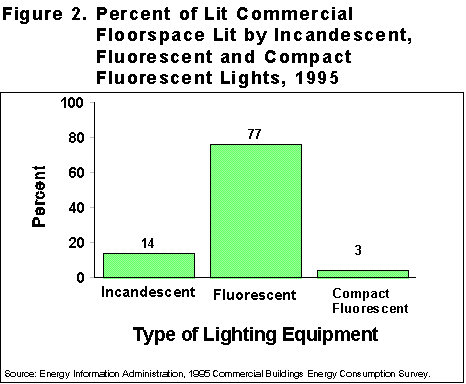
What Types of Lights Are We Using?
Two national EIA surveys report that . . .
Of residential households, 98 percent use incandescent, 42 percent use fluorescent.
Of commercial buildings, 59 percent use incandescent, 92 percent use fluorescent.
At a glance, we might conclude that substantial energy savings could occur in both the residential and commercial sectors if they replaced their incandescent lights with fluorescent lights, given that fluorescent lights consume approximately 75-85 percent less electricity than incandescent lights. In the residential sector, this is true. However, in the commercial sector, where approximately 92 percent of the buildings already use fluorescent lights, increasing energy savings will require upgrading existing lights and lighting systems. To maximize energy savings, analysis must also consider the hours the lights are used and the amount of floorspace lit by that lighting type. Figures 1 and 2 show the types of lights used by the percent of households and by the percent of floorspace lit for the residential and the commercial sectors, respectively.
Residential Energy Consumption Survey (RECS) . . .
Nearly all (98 percent) households use incandescent lights, 42 percent use fluorescent lights of any type, and 9 percent use compact fluorescent lights (Figure 1). However, when the actual use of types of lights is considered, only 13 percent of the lights used for 1 or more hours per day are fluorescent, and less than 1 percent of lights used for 15 minutes or more per day are compact fluorescent.

Commercial Buildings Energy Consumption Survey
(CBECS) . . .
Approximately two-thirds of all commercial buildings use
incandescent lights, but only 14 percent of lit floorspace is lit
by incandescent lights, while approximately 77 percent is lit
by fluorescent lights and approximately 3 percent is lit by
compact fluorescent lights (Figure 2). CBECS also collects information on two other types of lighting equipment--halogen and high-intensity discharge (HID). Of lit commercial floorspace, 2 percent is lit by halogen lights and 8 percent is lit by HID lights (Table 3).

Potential for Energy Savings
In the Residential Sector . . .
The greatest potential for energy savings in the residential sector occurs for lights that are used for longer periods of time. Therefore, potential savings are calculated for only those lights used for 4 or more hours per day. This analysis also assumes that compact fluorescent lights need about one-third the wattage of incandescent lights. Although an 18-watt compact fluorescent light produces the same number of lumens as a 75-watt incandescent, issues of light placement and color quality make a higher wattage compact fluorescent light more suitable.

In 1993, U.S. households used a total of 90.8 billion kWh for electricity for lighting. If households replaced all
incandescent bulbs used four or more hours per day with compact fluorescent lights, they could save 31.7 billion
kWh annually, or 35 percent of all electricity used for residential lighting (Figure 3).
In the Commercial Sector . . .
In 1995, U.S. commercial buildings used a total of 352 billion kWh of electricity for lighting. Although some energy savings would occur by simply replacing incandescent lights with fluorescent lights, CBECS data suggest greater energy savings will occur by replacing existing fluorescent lights with more energy-efficient equipment such as electronic ballasts, which increase fluorescent efficiency by up to 25 percent. For example, a study of a 440,000-square-foot office building in Washington, DC, which rewired T-12 fluorescent lamps and magnetic ballasts with smaller-diameter T-8 lamps and electronic ballasts, revealed a potential for annual savings of about 290,000 kWh, worth $27,000 per year to the building owner. Power per fixture was reduced by 20 percent, from 110 watts to 88 watts [Harris et al. "Monitored Savings from Energy-Efficient Lighting in DC Office." Center for Building Science News Spring 1997. Vol.4 No.1]. The 1995 CBECS reported that 48 percent of total commercial floorspace (56 percent of lit floorspace) was served by fluorescent lights with energy-efficient ballasts. There remains a significant fraction of commercial building floorspace that can be upgraded with more energy-efficient lighting equipment.
Links to Related Government Sites
 Energy User Page
Energy User Page
File Last Modified: January 15, 1998

- Contact for Residential Lighting:
- robert.latta@eia.doe.gov
- Robert Latta
- Team Leader, Consumption Analysis & Survey Design
- Phone: (202) 586-1385
- Fax: (202) 586-0018
- Robert Latta
- Contact for Commercial Lighting:
- Joelle Michaels
- joelle.michaels@eia.doe.gov
- CBECS Manager
- Phone: (202) 586-8952
- FAX: (202) 586-0018
- joelle.michaels@eia.doe.gov
URL: http://www.eia.doe.gov/emeu/cbecs/lit-type.html

If you are having any technical problems with this site, please contact the EIA Webmaster at
wmaster@eia.doe.gov
